With Burton making it to a major cup semi-final for the first time ever, it was more about the occasion than the game for Nigel Clough’s men. Pep Guardiola and his team looked to make sure that there weren’t any ‘cup shocks,’ which are part of the fabric of English football. This was a game between the English Premier League champions, playing with a strong starting 11, and the League 1 mid-table team. Manchester City were looking to make it two league cup triumphs in a row after their efforts last season. Only a professional performance would suffice. With the other League Cup semi-final finely poised for the second leg, this game was the complete opposite. A nine-goal victory over their counterparts has all but booked the Citizens’ place in the Wembley final.
Lineups
Manchester City (4-3-3): Muric; Walker, Garcia, Otamendi, Zinchenko; Gündoğan, De Bruyne, Silva; Mahrez, Jesus, Sane.
Burton (4-3-3): Collins; Brayford, Buxton, Turner, Hutchinson; Wallace, Allen, Fraser; Myers-Harness, Boyce, Akins.
Burton’s approach
Burton set up in a 6-3-1 out of possession. One of the main components of Burton’s approach was to deny Manchester City any space between the members of the back line. By having their wingers, Myers-Harness and Akins, adding numbers to the back four, they looked to double up on both Sane and Mahrez, to create a 2v1 in wide areas in defensive situations.
Playing three in midfield with one holding player, Wallace controlled the movement between the lines and two players playing man-to-man in midfield, with the striker Boyce playing as a player on top of the diamond standing on Gündoğan to deny space in the middle of the pitch. This approach was meant to frustrate the Manchester City players and allow them possession in front of their low block, mainly on the sides. Nigel Clough tried to force crosses from deep areas, confident in his players’ defensive heading abilities.
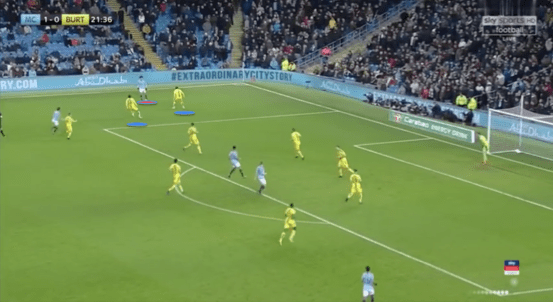
The image shows Leroy Sane blocked on the sides with Burton having enough numbers in the box to cope with Manchester City’s threat. Burton shuffle across the pitch to maintain the numerical advantage. The same happens as it moves to the other side. Manchester City found it difficult to switch the play and find any vertical lanes, because of the organised set up by Burton Albion.
City’s response: Two wide men the key
With Burton playing in a deep and compact shape, Pep Guardiola and his men found the perfect set up in order to pull opposition’s players out of their positions and uncover spaces to exploit. The half-spaces. The first feature of the set up was playing with two wide men who would hug the touchline. This pushed Burton to stick to their plan of doubling up in wide areas, leaving either Zinchenko or Walker unmarked in the midfield. With one player unmarked, it allowed them to control the inside channels and add extra players in the middle, outnumbering Burton at all times in the middle with a 4v3. As well as that, they were able to make unmarked runs, pulling Burton’s midfield three out of position.
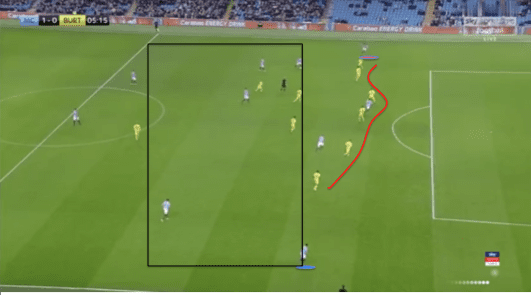
With Sane and Mahrez playing high and wide, they were able to stretch Burton’s back six horizontally, denying them the depth in other areas of the pitch. The inside channels were left vacated, making it difficult for any defensive player to get out in time to reach any player in possession in this area.

As we can see in the image above, both wingers were mainly left to play on the shoulder of the last man at different points in the game. The runs they made forced Burton to sit deeper and stopped them from pushing up comfortably, worrying about the space in behind.
With the pace of Sane and the passing ability of De Bruyne and Silva, it would have been a risky tactic to adopt by Burton. However, a tactic we’ve seen by all Pep Guardiola teams were the unselfish runs that his wide men make. With Sane and Mahrez’s runs taking away two players at a time, Zinchenko, Walker, Silva, and De Bruyne had a 4v3 numerical advantage, allowing them to move into the spaces in the inside channels to make the penetrating passes they were looking for. This created several opportunities down the side and through the middle for Gabriel Jesus, who scored four.
Half-space
All the different movements and patterns of play that Manchester City demonstrated in the game were to vacate the half-spaces for David Silva and De Bruyne to occupy. With Burton playing a line of six and three in midfield, the spaces emptied were ones that were usually going to be taken by a defending winger.
By having no players positioned there, Pep Guardiola’s men used these zones as areas where the most danger can be created. It is a space where it is difficult to find players to defend as it is positioned between two or three players. If a defending player comes out to defend a player in the half-space, the space that was supposed to be occupied was now vacated. This enabled Manchester City to pull the Burton players out of position, playing quick combinations to find the spaces in behind. As the game progressed, Pep Guardiola realised the key areas in which his team were operating, and ordered at least two players to support the player in the area, giving him good options in a position where space was afforded.
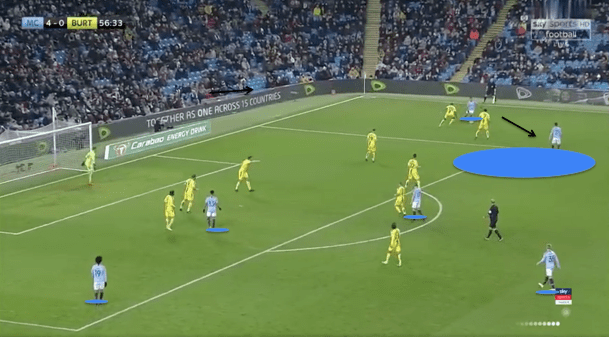
Numbers in the box
With Burton keeping 6 at the back during long possession periods for Manchester City, Pep Guardiola always allowed one of his advanced midfielders to help Gabriel Jesus in the box. This allowed more numbers in attacking areas. This also allowed a 6v4 to Burton in defensive areas, not ideal given the quality of the four players they were up against.
Having the numbers, City were able to have players in between the lines often dragging players out of position, creating the opportunities to exploit the spaces and play in behind Burton’s defensive line. As well as that, the numbers allowed Sane and Mahrez to find possibilities for cutbacks, with three players in the box at all times, Gabriel, an attacking midfielder, and the opposite winger, with others making late runs into the box. With the inside channels, as mentioned, vacated for Zinchenko and Walker, deep crosses were made in the box with more numbers allowing Manchester City to get on the end of them to finish off the actions.
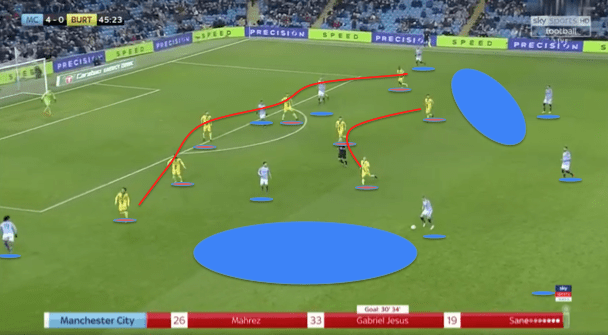
Manchester City in offensive transition
Manchester City did not counter-press regularly as they allowed Burton to come out with the ball, trying to exploit the spaces left. Guardiola set up to counter-attack by having both Sane and Mahrez high, with Gabriel moving in between the lines. Having these three players ahead of the ball allowed Manchester City to utilise their pace to gain a dynamic advantage over their defenders and get in behind the defensive line.
This forced Burton to keep five men back at all times, the back four and the holding midfielder. Manchester City were able to counter-attack quickly with and had many situations where they attacked with a 5v5 in Burton’s half, creating many dangerous opportunities. The counter-attacks were composed of the ball carrier, one runner from midfield, and Manchester City’s three forwards.
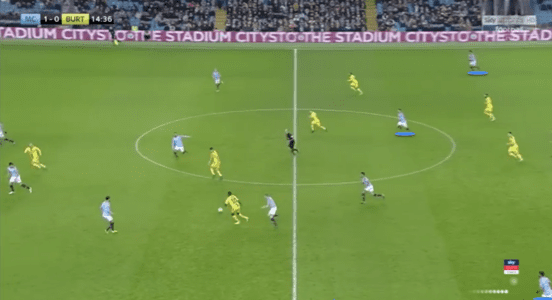
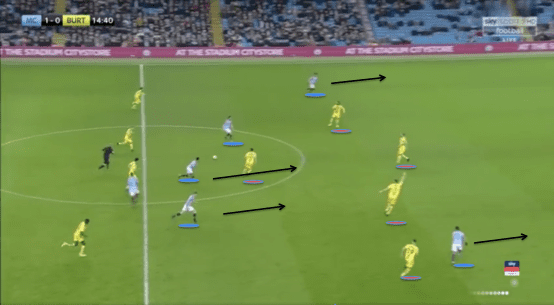
In the pictures above, Manchester City place their forwards in a position where they are dangerous when their teammates regain the ball. Within four seconds, they are 5v5 in their half.
Conclusion
Manchester City produced a very professional performance in search of booking their place in the final by the end of the 90 minutes. With the movement and quick football, Guardiola’s team were able to pull Burton’s players out of position and find the spaces to counteract their deep block.
Burton were always facing an uphill challenge as they were facing one of the best teams in Europe. They held City for half-an-hour, keeping the score only 1-0. It will be all about the league this season for Burton, who still have the task of the return leg of the semi-final, which they will be looking to give a more positive reflection of what they can do. For Manchester City, their focus now turns to the league, where they have a four-point gap to make up to Liverpool and the UEFA Champions League, in order to snatch the trophy off Real Madrid‘s hands.
If you love tactical analysis, then you’ll love the digital magazines from totalfootballanalysis.com – a guaranteed 100+ pages of pure tactical analysis covering topics from the Premier League, Serie A, La Liga, Bundesliga and many, many more. Get your copy of the FIRST of two December issues for just ₤4.99 here, or the SECOND of the December issues with an annual membership right here.





Comments